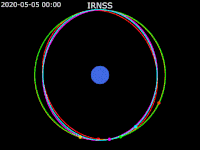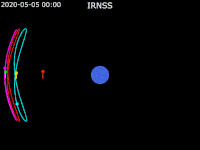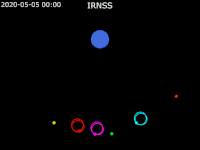 | |
| Mission type | Navigation |
|---|---|
| Operator | ISRO |
| COSPAR ID | 2016-015A |
| SATCAT no. | 41384 [1] |
| Website | http://www.isro.gov.in/Spacecraft/irnss-1f |
| Mission duration | 12 years |
| Spacecraft properties | |
| Spacecraft | IRNSS-1F |
| Spacecraft type | Satellite |
| Bus | I-1K |
| Manufacturer | ISRO Satellite Centre Space Applications Centre |
| Launch mass | 1,425 kilograms (3,142 lb) |
| Dry mass | 598 kilograms (1,318 lb) |
| Power | 1660 W |
| Start of mission | |
| Launch date | 10:31:00, March 10, 2016 (UTC) |
| Rocket | PSLV-XL C32 |
| Launch site | Satish Dhawan Second |
| Contractor | ISRO |
| Orbital parameters | |
| Reference system | Geocentric |
| Regime | Sub-Geosynchronous Transfer Orbit (sub-GTO)[2] |
| Perigee altitude | 35,708 km (22,188 mi)[3] |
| Apogee altitude | 35,862 km (22,284 mi)[3] |
| Inclination | 32.5 deg E |
IRNSS-1F is the sixth navigation satellite out of seven in the Indian Regional Navigational Satellite System (IRNSS) series of satellites after IRNSS-1A, IRNSS-1B, IRNSS-1C, IRNSS-1D and IRNSS-1E. The satellite is one among the seven of the IRNSS constellation of satellites launched to provide navigational services to the region.[4]
Launch
[edit]It was launched aboard a PSLV-XL rocket bearing flight number C32 and was successfully put into geosynchronous orbit at 1601 hrs IST on 10 March 2016.[5][6]
Spacecraft
[edit]The satellite carries two types of payloads. The navigation payload transmit navigation service signals to users and ranging payload consists of C-band transponder that facilitates accurate determination of the range of the satellite.[4]
It carries Corner Cube Retro Reflectors for laser ranging.[7]
IRNSS-1F has a 12-year mission life.[2]
See also
[edit]- Communication-Centric Intelligence Satellite (CCI-Sat)
- GPS-aided geo-augmented navigation (GAGAN)
- Satellite navigation
References
[edit]- ^ "NORAD Catalog Number 41384". www.celestrak.com. Retrieved 2017-06-08.
- ^ a b "ISRO successfully launches navigation satellite IRNSS-1F.Earlier satellite launch of IRNSS 1E was in January 2016 - PSLV C31". Retrieved 2016-03-10.
- ^ a b Peat, Chris (2022-10-07). "IRNSS 1F". Heavens-Above. Retrieved 2022-10-08.
- ^ a b "India's sixth navigation satellite, IRNSS-1F, put into orbit". The Hindu. 10 March 2016. Retrieved 2016-03-10.
- ^ "IRNSS". space.skyrocket.de. Retrieved 6 December 2014.
- ^ "IRNSS-1F". isro.gov.in. Archived from the original on 8 March 2016. Retrieved 9 March 2016.
- ^ "IRNSS-1F - ISRO". www.isro.gov.in. Archived from the original on 2017-07-31. Retrieved 2017-06-08.







Well, that’s interesting to know that Psilotum nudum are known as whisk ferns. Psilotum nudum is the commoner species of the two. While the P. flaccidum is a rare species and is found in the tropical islands. Both the species are usually epiphytic in habit and grow upon tree ferns. These species may also be terrestrial and grow in humus or in the crevices of the rocks.
View the detailed Guide of Psilotum nudum: Detailed Study Of Psilotum Nudum (Whisk Fern), Classification, Anatomy, Reproduction